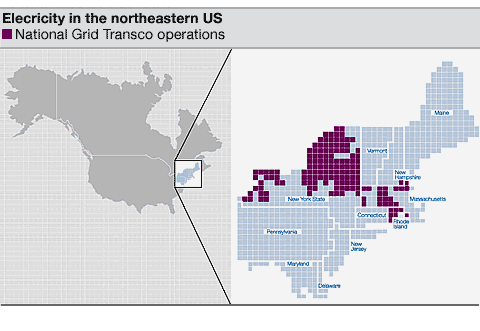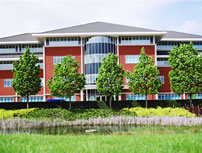
Executive Reports
Operating Performance

- Chairman’s Statement
- Chief Executive’s Review
- Operating Safely
- Operating Performance
- Investing for Growth
- Investing in our People
- Our Responsibility for the Environment
- Our Responsibility to Society

In November 2004, we opened the new Gas National Control Centre, from where the gas National Transmission System (NTS) is operated. The centre represents an investment of £3.3 million and is equipped with the latest technology to cope with the increasing network and commercial complexity we expect in the next few years.

- UK Transmission
- US Transmission
- UK Gas Distribution
- US Distribution
- Wireless infrastructure
- Other operations
UK Transmission
Our drive to be the premier network utility means we need to ensure the reliability of the electricity and gas networks through operating them and investing in them in an efficient and economic way. Our reliability in the electricity market last year has been bettered only once in the last decade. During 2004/05, our reliable delivery of electricity equated to 99.99998% of energy demanded during the year. We have maintained the average annual availability of the UK electricity network at 95.3% in 2004/05. Internationally, we are one of the world leaders in terms of transmission reliability.
In 2005, Ofgem introduced a new incentive scheme which allows us to receive payments if we maintain or improve reliability of the England and Wales electricity transmission system by delivering above average reliability of the network. The incentive target equates to a level of reliability of better than 99.9999%.
Over 2004/05, the performance of our compressor fleet improved, with the average time between compressor failures 24% above our five-year average. The compressors are used to maintain the pressure at key points on the gas transmission system and the ability of the system to transport the available gas is dependent on the performance of our compressor fleet.
On 1 April 2005, changes were introduced such that the electricity transmission and trading arrangements for England and Wales were extended to apply across Great Britain. We took on responsibility for managing the operations of the Scottish electricity transmission system as well as that in England and Wales. As system operator of the electricity network in Great Britain, we are incentivised to keep the costs of balancing supply and demand as low as possible against a defined target. The benefits of savings against this target are shared with customers. To carry out these enhanced responsibilities, we have installed new systems to manage electricity operations across Great Britain, including the integrated energy management system.
US Transmission
In the US, we provide electricity transmission in New York through Niagara Mohawk Power Corporation and in New England principally through New England Power Company.
Our US Transmission business in New England operates co-operatively within an independent system operator (ISO) with responsibility for overall system operation and coordination of the regional transmission system for the whole of New England. With effect from 1 February 2005, ISO New England became the regional transmission organisation for New England, giving us the opportunity to seek a higher allowed return on equity, for which an application is currently under review by the Federal Energy Regulatory Commission.
In addition, in the midwestern US, our
GridAmerica business manages a range of
electricity transmission operations on behalf
of its participant utilities. It was the first multisystem
independent transmission company
and was formed under agreements with
three partner companies and the Midwest
Independent System Operator (MISO). After
careful review with our partners, GridAmerica
will cease operations on 1 November 2005.
The Group will be looking to reapply the skills
and knowledge brought to its participation in
GridAmerica as it seeks to develop interests
in North America.


The 'Way Ahead' restructuring programme is well advanced as we move to a new unified structure which is supported by two key centres, one in Hinckley and the other at our new office in Northampton (pictured above). This will enable us to place increased emphasis on safety and efficiency, and share best practice across the organisation.
UK Gas Distribution
We have met or exceeded almost all of our major performance targets. Requests to connect homes or businesses to our gas network must be carried out to meet certain connections-related standards. Our performance against these connections related standards has improved significantly during the latter part of 2004/05. However, Ofgem is currently investigating our performance against these standards for 2003/04.
Over the year, considerable work has gone into the planning and execution of the sale process within our UK Gas Distribution networks. At the same time, our 'Way Ahead' programme of restructuring the four retained networks is well advanced. Our aim has been to create a more unified structure for the retained business, which will enable us to place increased emphasis on safety and efficiency, and share best practice across the organisation. This business will distribute gas to around 11 million consumers, including those in parts of London, Birmingham, Manchester and Liverpool, in a network covering just over a quarter of Great Britain. We aim to make it the most efficient UK gas distribution network.

In the US, we recently launched the first test of a field force automation programme, giving computers to a group of our supervisors in the field. In the coming months we plan to expand the programme to more of our field workers and to introduce features that will allow us to locate workers, delegate assignments and monitor their status in real time in order to improve our efficiency.
US Distribution
Our US Distribution business met or exceeded the majority of its service standards for reliability, customer service and safety. However, we did miss some reliability targets and we recognise that we need to reduce the inconvenience customers suffer with supply interruptions, as well as enhance safety and standardise best practices. We have a number of plans to do this. One key scheme is to reduce the frequency and duration of interruptions by boosting our investment in asset enhancement, replacement and maintenance in the coming year and beyond. This will ensure that resources are used efficiently to respond to outages and create a safer work environment.
In October 2004, we agreed a new 42-month contract with our labour union in New York. Together with last year's agreement with our New England unions, the new contract will allow us to increase productivity through more efficient working practices, and to improve safety and service.
The people who know our operations best are our employees. In 2004/05, we formed a joint efficiency team charged with seeking and evaluating their ideas for innovation. We are already sharing best practices across the US and between our UK and US operations.
Other initiatives during the year include the merger of information technology functions across the New York and New England regions and the implementation of new financial and work management systems. We also completed the conversion to automated meter reading for our residential customers, one of the largest projects of its kind in the US, which allows meters to be read from the street by a specially equipped vehicle. About 3.6 million devices are now in service, helping reduce customer inconvenience and improve customer satisfaction.


A typical example of a Crown Castle UK tower capable of carrying broadcast services and multiple site share tenants. Site sharing minimises the number of towers needed to provide national coverage.
Wireless infrastructure
Following our acquisition of the UK operations of Crown Castle International Corp., we are the leading independent provider of network infrastructure to mobile operators and one of two providers of transmission networks for analogue and digital television and radio broadcasters in the UK.
Through Crown Castle UK, we own two licences for scarce digital channel capacity.
The availability of the BBC's priority TV services has not fallen below 99.96% since the Crown Castle acquisition, compared with a contracted target of 99.9%.
Other operations
We operate two UK Metering businesses, Transco Metering and OnStream. Transco Metering played a major role in the four-year industry-wide project to develop new contracts, industry processes and information systems to support Ofgem's Review of Gas Metering Arrangements, implemented in July 2004. During 2005/06, it is our intention to bring together the two businesses under a single legal entity, reinforcing our position as the national leading provider of utility metering services in Great Britain.
Our gas connections business, Fulcrum Connections, is being restructured so that the domestic connections activity it carries out for UK Gas Distribution will be reintegrated into the retained distribution networks over the coming year.
During 2004/05, we also consolidated all of our UK property holding and management activities into a single unit, Property Services Group. Through its SecondSite Property arm, it is responsible for the management, clean up and disposal of surplus non-operational properties.

